I contacted Cilogear and ordered a hipbelt Apr-17-2023. I spoke to them Jun-20-2023 and I was told it would ship that week. I spoke to them Jul-25-2023 and was told it would ship that day. I spoke to them around Aug-03-2023 and was told it should arrive Aug-04-2023. It never arrived. I sent them some emails and called them several times. No emails were answered and they never answered their phone again. I have seem a few posts on Facebook from Cilogear. I don't know if the company is still in business. I don't know if you order gear that it will ever arrive. I think they make great gear, but you need a company to stand behind their gear.
As a point in contrast, I bought a very high quality sleeping bag on ebay that was made in 1995. It had an issue and needed to be repaired. Even though the company had moved twice since 1995, they still existed. They answered my email within a day or so. I shipped them the broken part, and in a few weeks I had the repaired/replaced part back.
I bought a used CiloGear V3 75 WorkSack, size medium. This is a 75 liter pack which is designed for alpine climbing, which is somewhat different from a general purpose pack. It is designed to carry two ice tools (ice axes) as well as a pair of crampons. That isn't very unusual, as many packs have the same features. The way the ice tools and crampons are attached are of a superior design to other packs. The pack is generally of a streamlined design, with little sticking out. That is pretty important for a climbing pack, but not so important for general use. It's construction is a bit more complex than any other pack that I am familiar with, and it is made with more different materials than any pack that I am familiar with. It is more modular and configurable than any other pack that I know of. The quality of workmanship is first rate, and overall it is the best designed pack that I have ever seen. The pack was not complete when I bought it, so I bought a lid, new framesheet, Carbon Control Rod, and a new hipbelt from CiloGear to make the pack complete and somewhat updated.
The 75L differs from other CiloGear packs in several ways. The most notable is that is is larger and designed to carry heavier loads. It's framesheet is similar to other CiloGear packs however it also has a Carbon Control Rod (CCR) that augments the standard framesheet. The framesheet and Carbon Control Rod can be tensioned with the Transverse Stability Strap (TSS) which is unique to the 75L. There are also external wand/bottle pockets on the sides of the pack. There is also a zipper going across the lower section of the pack which can be used to access a sleeping bag or other stuff at the bottom of the pack. There is also a removable internal divider inside the pack which is just above the pack zipper. The way the hipbelt is tensioned to the pack is different on the 75L pack. The v3 pack belt has a dee clip on the hipbelt which a strap goes through. This creates a 2 to 1 pulley, allowing for more tension. It is called the Ratchet hipbelt. I bought my pack used, and there were no instructions for the CCR, TSS, or Ratchet hipbelt. In addition, there are no instructions on the CiloGear web site for the CCR, TSS or Ratchet hipbelt. The Ratchet hipbelt has been discontinued and the new hipbelt design is similar to the rest of the CiloGear hipbelts.
The v5 pack has tabs on the sides of the pack to attach a sled which are not present on my v3 pack. Also there is a dee clip and sliplock on the center back of the pack on the v5 pack which are absent on my pack. The central dee clip and sliplock seem to be present on all v5 packs except the 20L (tiny) pack. Also the v5 pack has a dee clip on the back, near the top of the pack. This makes it easier to compress the top of the pack via side compression straps. The top of the pack is thicker than the bottom of the pack, so this was a very useful improvement. For my pack, I fabricated a very long strap, roughly 24 inches, with a dee clip sew to one end. I attached it in a V going from the back to the front, to the upper back sliplock. Also present on the v5 pack, but missing on my v3 pack are two dee clips below the zipper on the back of the pack. I suspect these can be used to strap more stuff to the pack.
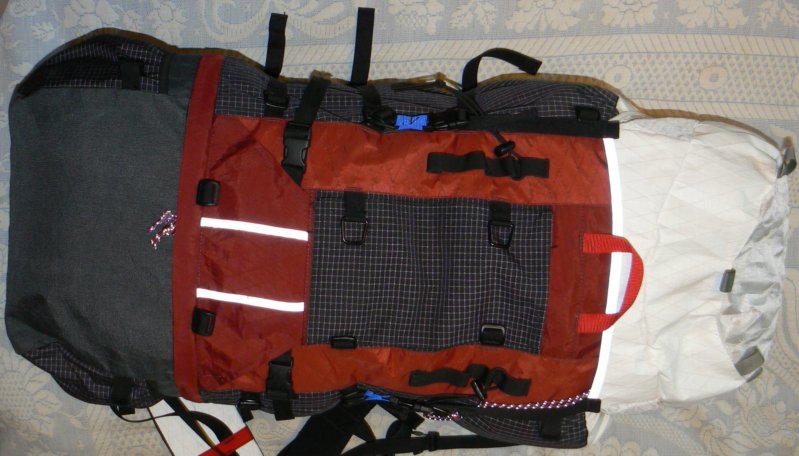
This is a view of the back of the pack. Many features of the pack are visible. The black patch in the center is a pocket for holding crampons. The two red triangle shaped pieces of material are where the heads of the ice tools go. The ice tool heads are secured with the side release buckles next to the red triangular material. The shaft of the ice tools are secured with the black cords that are higher up on the pack. The doubled cord is wrapped around the shaft, and then the cord is looped over the cord toggle. Then the cord toggle is tightened to secure the cord loop. The cord is 1/8 inch elastic. There is reflective material on the triangular ice tool flaps. Also the pack zipper is covered by a red flap, but the cords attached to the zipper pulls are visible.
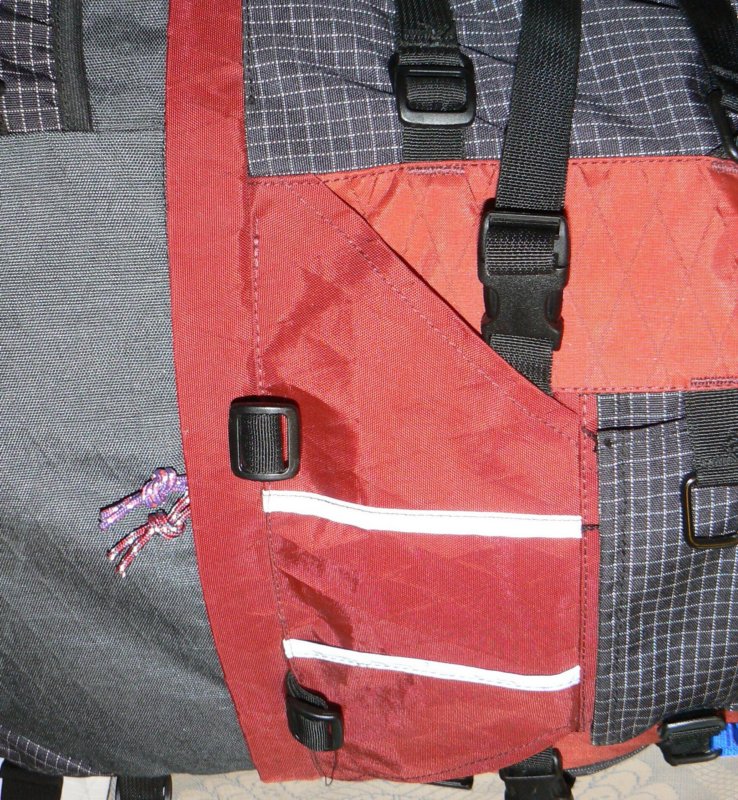
This is a close up of the tool holders on the pack. There is a flap of material sewn to the pack at both ends that secures the head of the tool. The shaft near the head is secured with the black side release buckle. The inside of the flap of material is edged with reflective material to make it easy to see in low light conditions. Under the flaps of material are sliplocks. Also visible is the crampon holder, made of black Dyneema / Cordura ripstop fabric (which used to be called spectrum) with a red bottom. Visible on the side of the crampon holder is a 'Dee-clip' which is what makes the pack so configurable. The v5 pack has a central lower dee-clip between the tool holders, but this is not present in the v3 pack.
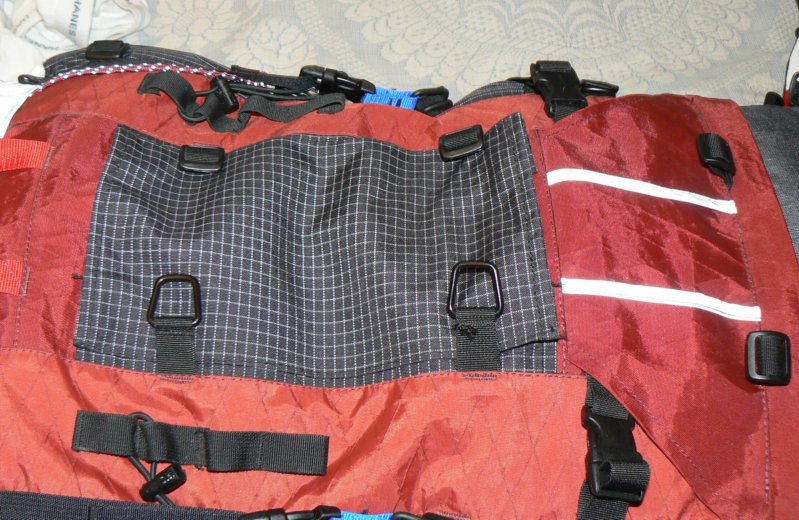
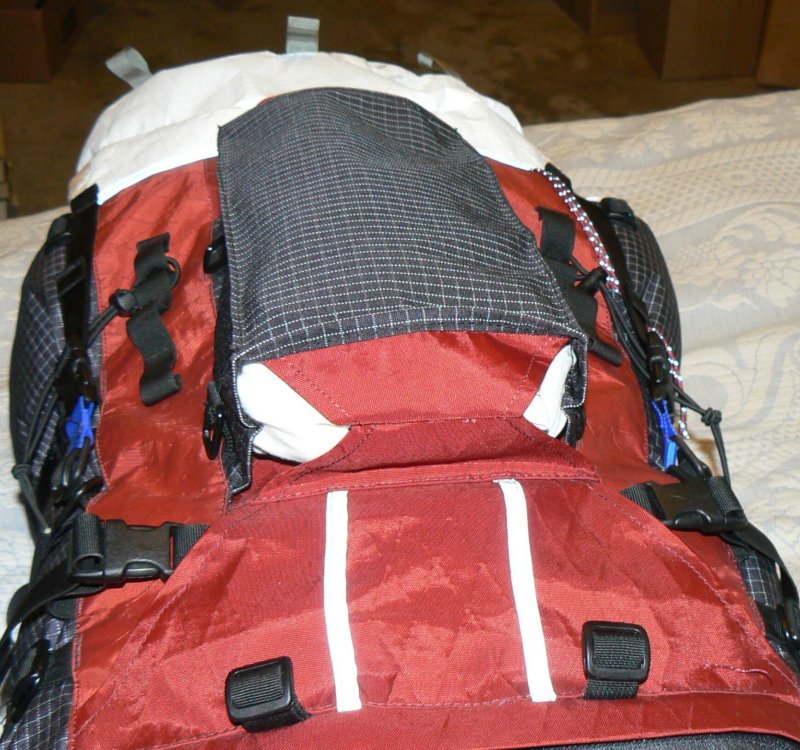
This is the crampon holder. Crampons have many sharp points, and when used get lots snow on them. The snow melts, which makes the crampons wet. It is a good idea to keep the crampons outside the pack so they don't get stuff inside the pack wet, and so the sharp points don't poke holes in anything. The second picture shows the bottom of the crampon holder. I stuffed in a white shirt, to fill the holder, and make the drainage holes on the bottom sides more visible. When the crampon holder is not in use, it folds flat against the pack. Of course, you can put whatever you want in the crampon holder, if you aren't using crampons. There are two pairs of attachment points on the sides of the crampon holder so two straps can be used to secure whatever is inside. I will add some cord laced over the crampon holder to keep it flat when not in use, and to help secure the crampons when inside.
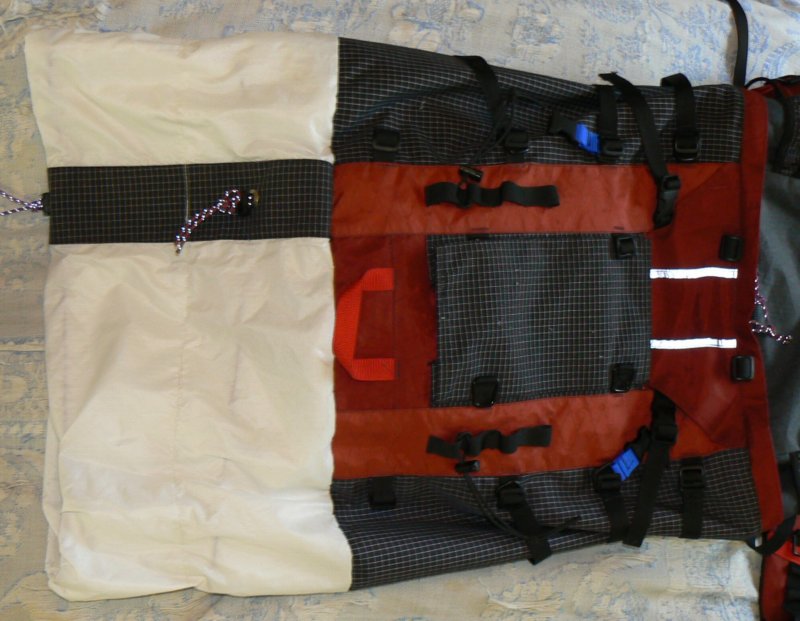
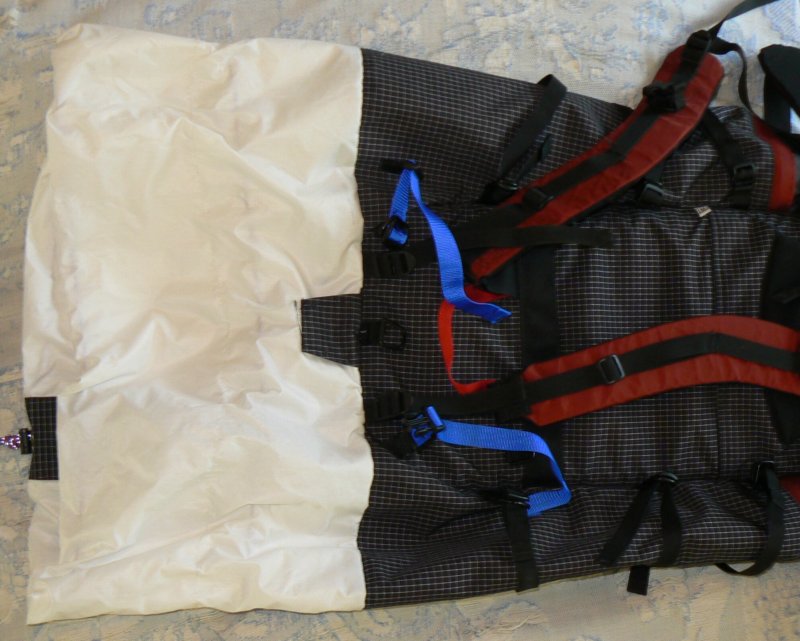
This picture shows the white pack skirt extension. It is made of two layers of ripstop nylon coated with silicone, which is a very lightweight, and abrasion resistant. Since it is usually inside the pack, it doesn't need to be as robust as the normal exterior of the pack. You can see there are two draw-cords, one near the bottom of the skirt, which is the one that is usually used. They are Sterling Rope's Glo-Cord, which is 2.75mm cord with a reflective exterior. When the skirt is used, the drawcord on the top of the skirt is used. Also visible in this picture is the red haul strap on the back of the pack. The trapezoidal black tab at the bottom of the skirt in the second picture is where a hydration tube can exit the pack.
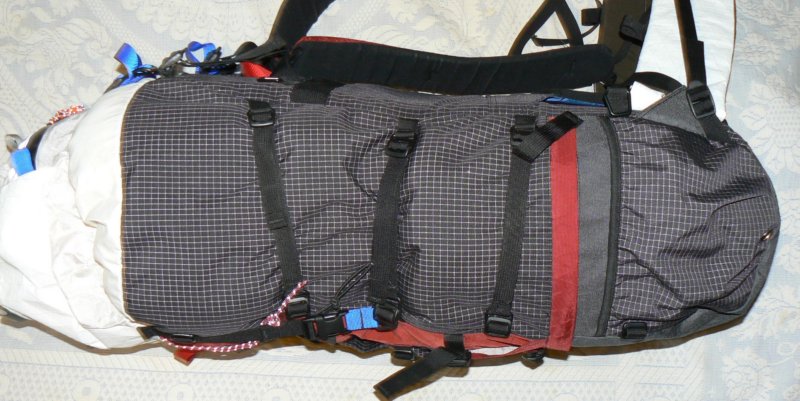
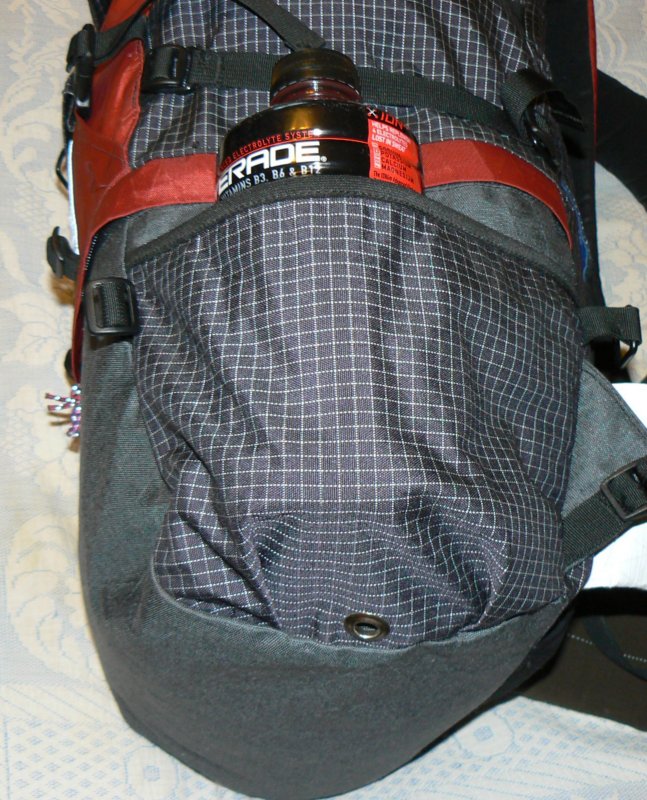
This is the side of the pack. The lid of the pack is on. Working down from the lid, are three compression straps. These straps are removable. You could add another compression strap below the lower black strap. This would go over the top of the side pocket. You can arrange the straps at a diagonal. Included with the pack, but not shown are more straps release buckles, as well as longer straps. The owners manual describes some of the many possible options for using the straps. The bottom of the pack is made of Dimension Polyant VX51 which is 500x1000d Cordura nylon on the outside, and has a total of 5 plies of material. It is quite robust. The second picture is a close-up of the side pocket. There is a grommet with a drainage hole at the bottom. There is a 32 oz bottle in the side pocket. The side pocket can accommodate a 64 oz bottle (2 liters) or snow wands and the like.
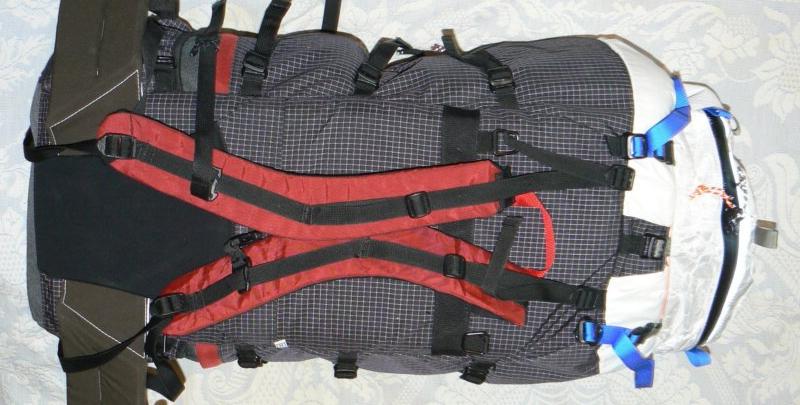
This is the front of the pack, i.e. the part which rests against your back. The lid is on the pack, and there is a reflective stripe of material next to the external lid zipper. The lid attaches to the pack with two adjustable blue straps, as well as a dee-clip in the center. If you use the skirt to load lots of stuff in the pack, the central dee-clip is disconnected and two higher dee-clips can be used to attach the lid, rather than the lower dee-clips. Next to the lid, is a red haul strap. Below that, is a piece of 1.5 inch wide black webbing. This is where the top of the shoulder straps attach to. The tops of the shoulder straps consist of two layers of 1.5 inch black webbing which is bartacked to the red material of the shoulder strap as well to the 1.5 inch wide black webbing on the pack. This makes a very strong flexible mounting point for the shoulder straps. Not visible, is the bottom of the shoulder straps which attach to a double thickness triangle of material which is the same material as the bottom of the pack. The shoulder straps have load transfer straps which attach to the top of the frame of the pack, and their attachment point on the shoulder strap is adjustable with the black slider visible on the shoulder straps. There is also a removable sternum strap which is adjustable up and down. The shoulder straps are made with dense foam and a very hard outside layer.
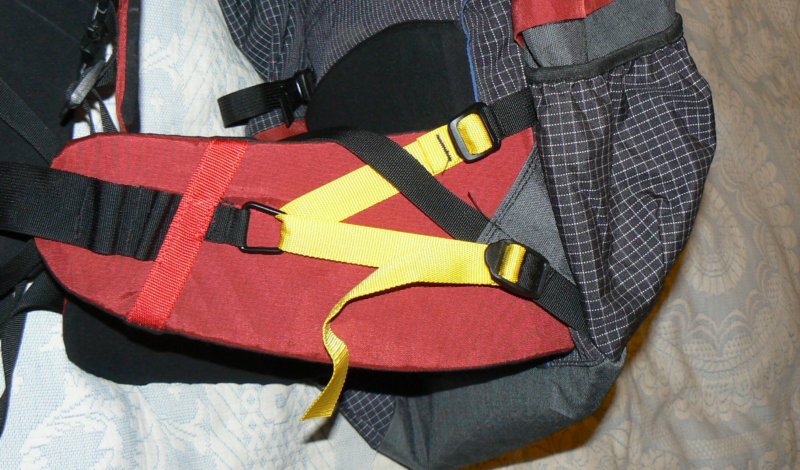
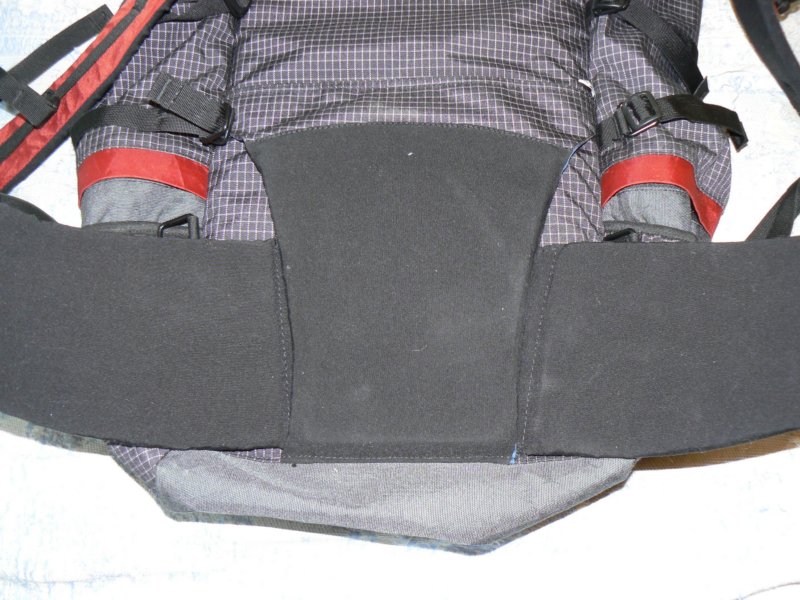
This is the hip belt. It is pretty similar in construction to the shoulder straps. It uses two layers of foam, like the shoulder straps. It is a bit taller than the v5 hip belt. The belt is a single piece, with some velcro in the center. On the bottom of the pack is a black, padded sacrum pad with a slot in it, and some velcro which mates with the hip belt velcro. The pack frame height is adjustable by three inches, based on how the hipbelt is attached. This is very similar to the way the Kelty cloud packs adjust. The close up of the belt shows the outside of the belt in red. There are attachment points on the end of the belt for gear loops, which are generally used to hold rock climbing gear while climbing. The hip belt attaches in the front using 1.5 inch webbing and a standard side release plastic buckle. The v3 75 liter hip belt is known as the ratchet hip belt, because of the way it attaches to the pack. There is a yellow 3/4 inch webbing which attaches to the pack, goes through a deeclip on the belt and attaches back to the pack. This provides a two-to-one pulley system to enable the pack to be pulled close to your body. The black webbing is where the shoulder strap attaches to the bottom of the pack. CiloGear stopped making this system, and the new 75 liter packs use a hip belt which is very similar to the rest of their hip belts.
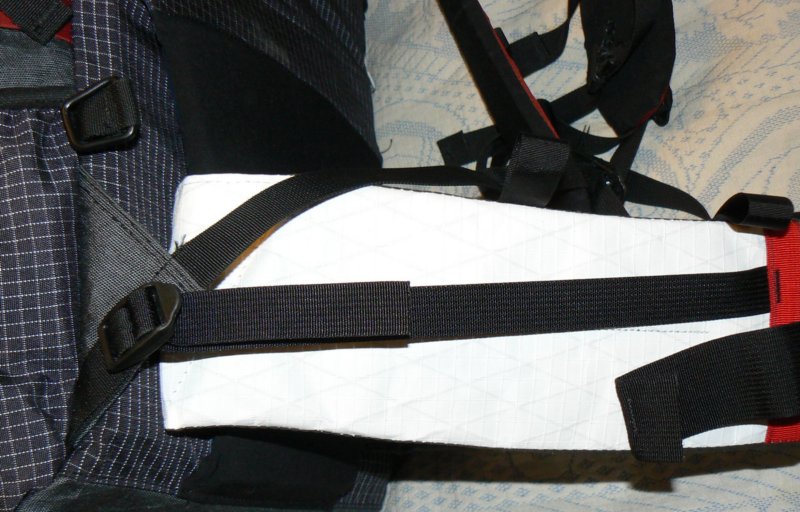
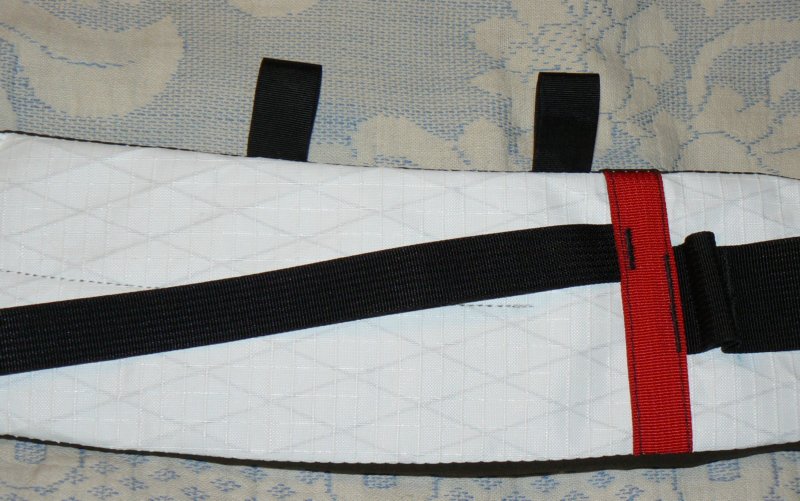
This is the new v5 hip belt. It is made out of spectra fabric. The belt design is unique to the 75 liter pack. It is pretty similar in construction to the shoulder straps. It uses several layers of foam. It is less tall than the v3 hip belt. The foam is softer than the v3 hip belt. It attaches to the pack via black 3/4 inch webbing. There is one sewn in gear loop in the 1.5 inch webbing, unlike the v3 belt which has two gear loops sewn in the 1.5 inch webbing. There are two gear loops in 3/4 inch black webbing which is visible in the second picture. These are nor found on any other CiloGear hip belt.
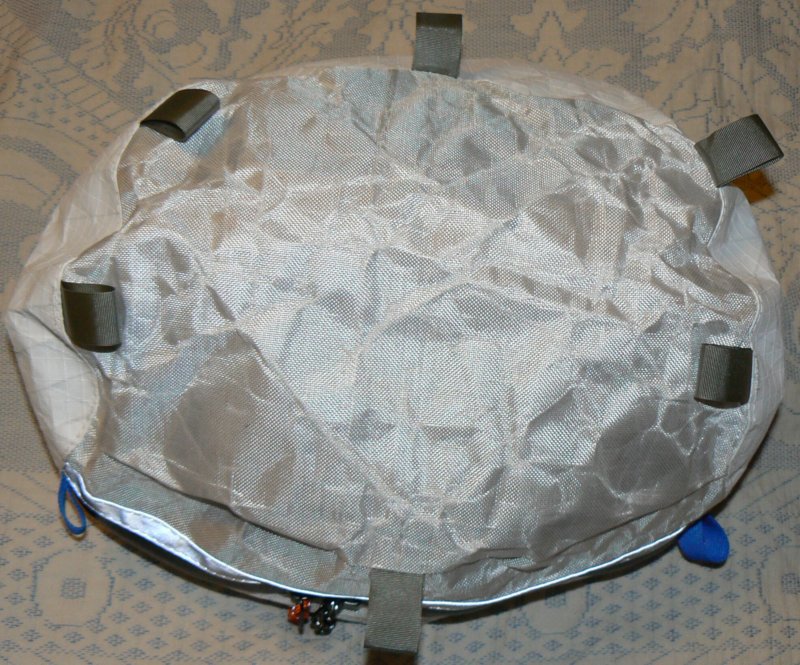
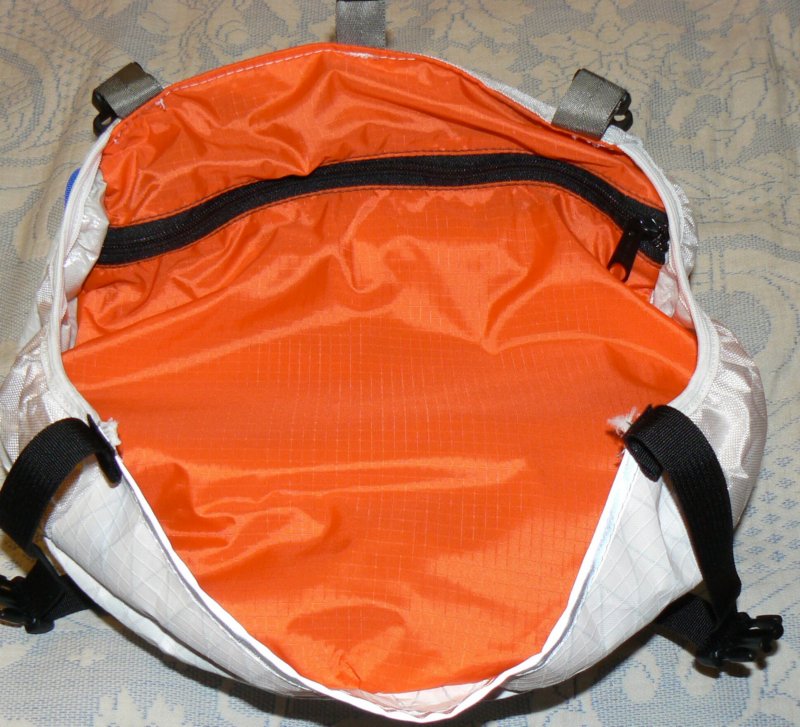
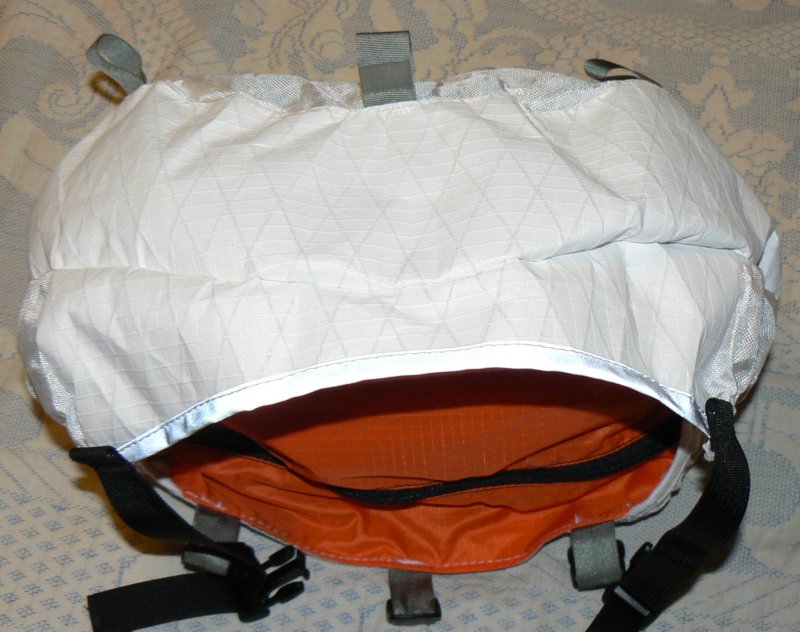
This is the new pack lid. It is made out of woven/non-woven (W/NW) Dyneema which is a fabric unique to CiloGear. Dyneema is also known as Spectra in the United States. The top is made out of heavy weave of Dyneema, and is quite shiny. There are six lash points around the perimeter of the lid. Cord can be attaches to these lash points to secure a climbing helmet or other bulky items. On the bottom of the lid is a separate compartment from the main lid compartment. The last picture shows the side view, which shows the reflective material at the bottom edge of the lid.
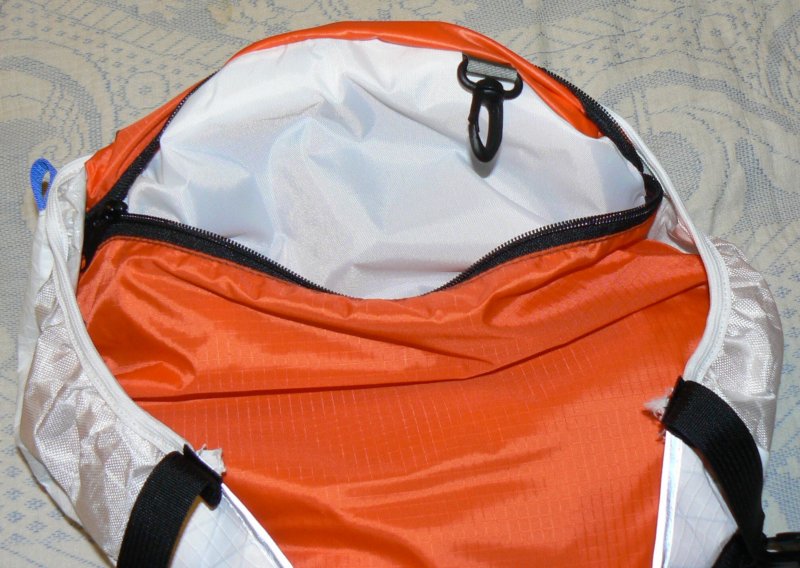
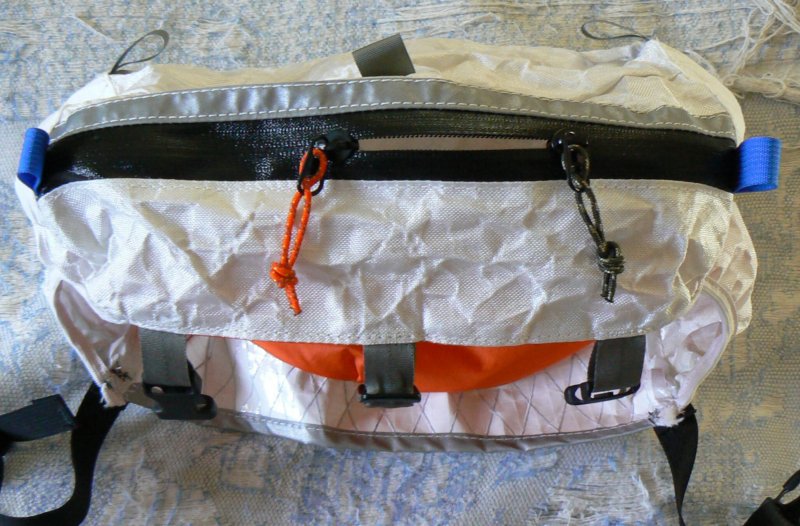
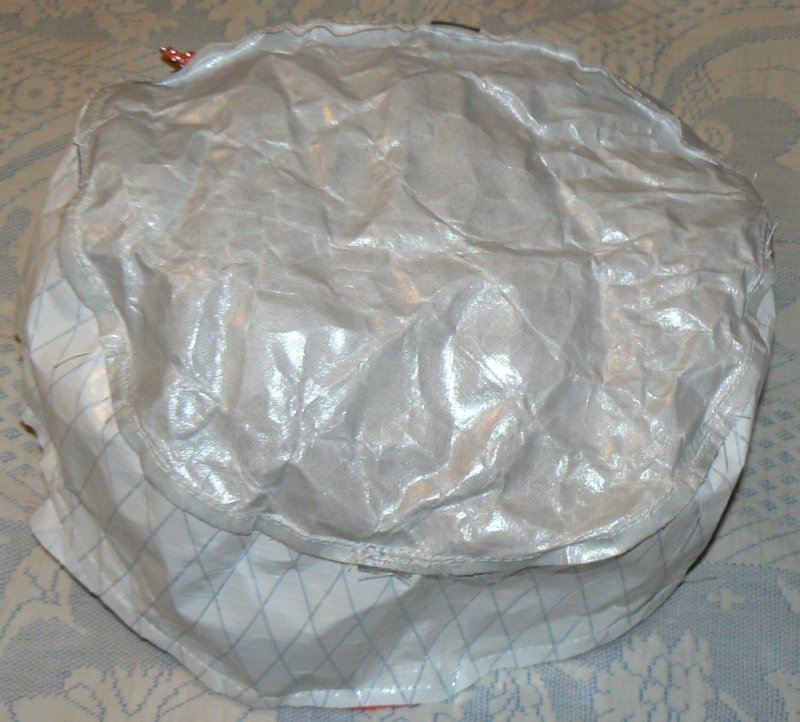
The first picture is the inside of the bottom pocket. The zipper is open, and a loop for keys or other small objects is sewn into the pocket. The next picture is of the main compartment zipper. It features two zipper pulls as well as an urethane coating on the zipper fabric and teeth for water proofing. You can see two blue straps at the ends of the zipper. I am not sure what their function is. The last picture is the lid inside out. The plastic film on the inside of the top Dyneema fabric is visible. You can see the inner layers of the lid side which I think is lighter W/NW Dyneema. It also has a plastic film. This seems to be more waterproof and durable than coated Spectra/Dyneema fabric. Since the main pack has a drawstring, the lid isn't really needed, and can be left off if desired.
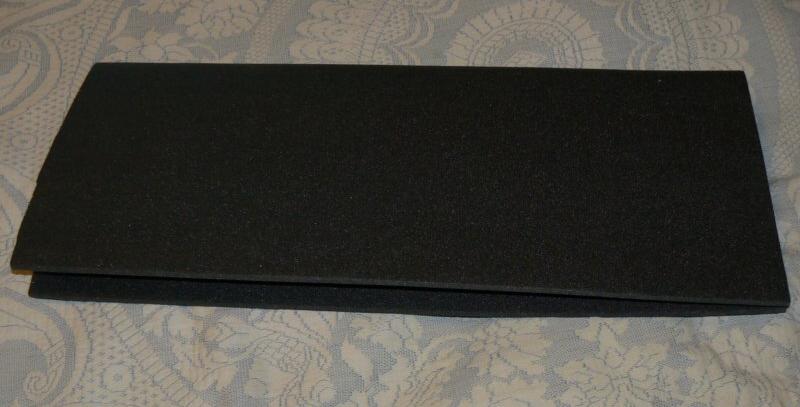
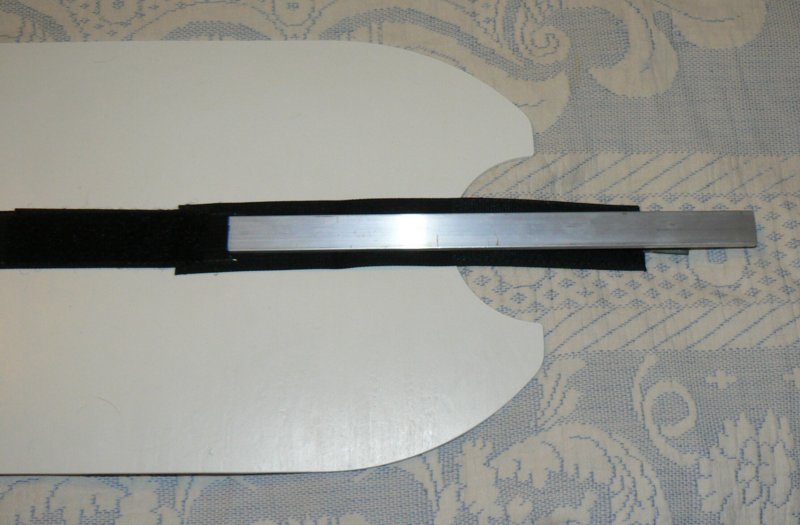
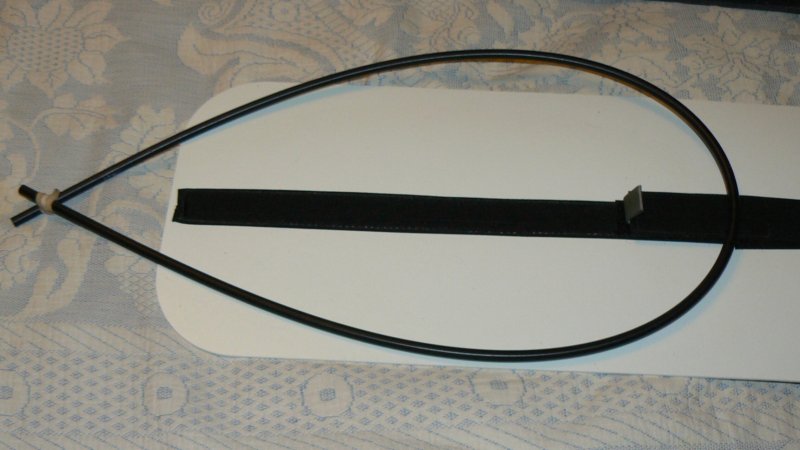
The CiloGear 75 liter pack has the most complex frame of any CiloGear pack. This is to support greater loads, as this is their biggest pack. The frame consists of a piece of foam, a frame sheet, an aluminum stay, and a carbon control rod (CCR). The CCR is unique to the 75 liter pack. The first picture shows the foam sheet which is thin, and quite dense foam (10 lb per cf) folded in half (its black). The second picture shows the thin framesheet (its white) made of HDPE. In the center of the framesheet is black material which contains a pocket for an aluminum framestay. The stay has been partially removed to make it visible. The last picture shows the closed pocket of the framesheet. The top of the pocket is secured with velcro. There is a nylon fabric tab to make it easier to open to remove the stay. This is a newly purchased v5 framesheet. In addition the CCR is visible. I used a rubber band to secure the ends as it is quite springy.
There are some people who think frames aren't necessary. Perhaps for actually doing technical climbing, or for really light loads under 20 lbs. For all other occasions, I really like having a frame to transfer the weight. The frame is modular, and you can remove all of them, or use any combination of the three frame components.
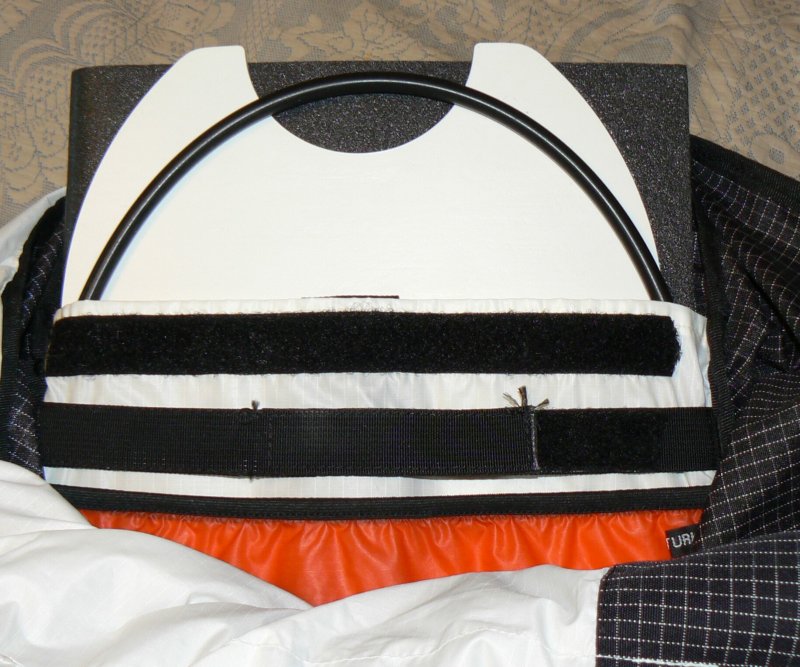
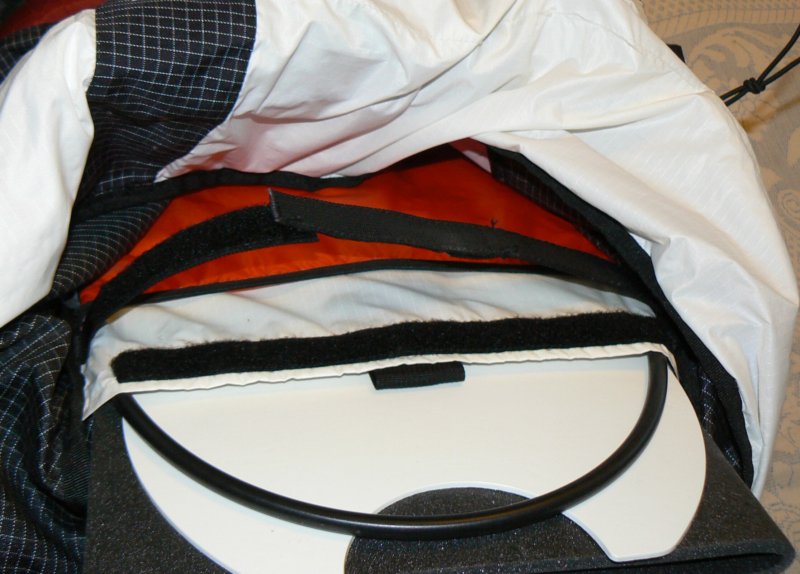
The first picture shows the complete frame inserted in the pack. The part closest to your back is the foam sheet. Next is the plastic frame sheet, and finally the CCR. The top black strip is velcro which is used to secure the interior pack pocket, which holds the frame in the pack. The lower black strip is the Transverse Stability Strap (TSS), which can be used to tension the CCR. The second picture shows it secured very loosely to make it more visible. It is secured with velcro.
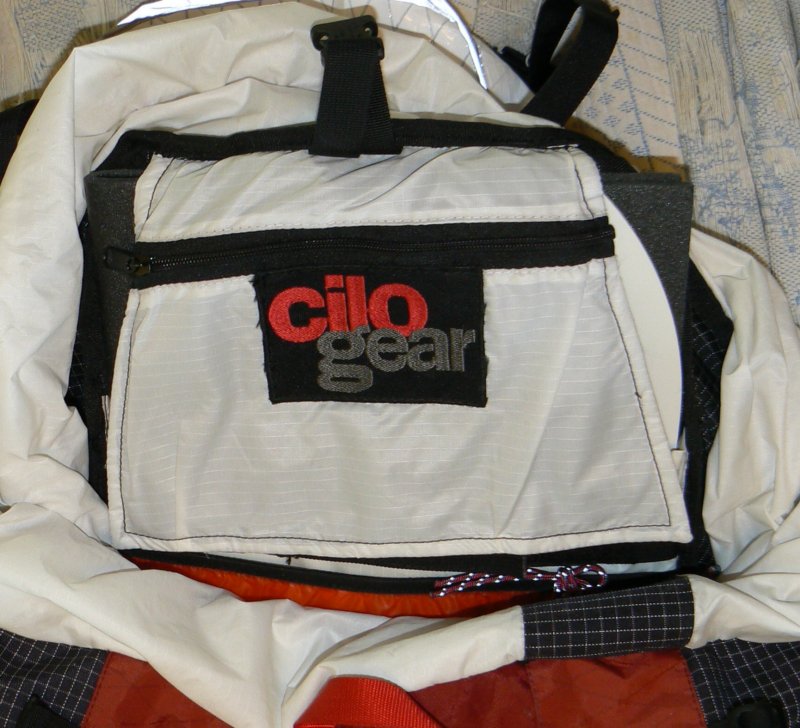
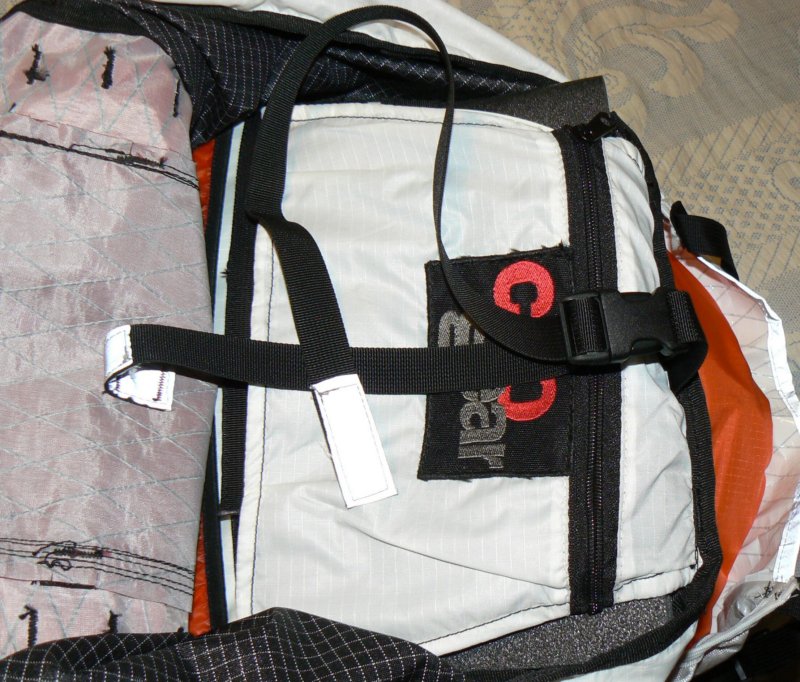
The foam, framesheet and CCR go inside a pocket inside the pack. The top of the frame pocket has a flap that folds over and velcros to secure the frame. On the flap is a white zippered gear pocket. Another feature of this pack is an internal compression strap which is visible in the second picture. The end sewn to the pack has some reflective fabric on it, as well as the other end of the strap. There is a plastic side release buckle for the compression strap. The v3 pocket is has a 2 by 4 inch CiloGear logo patch. My v3.5 and v5 CiloGear Spectra packs have a large open pocket next to the framesheet, made out of silnylon. It is for a hydration bladder, and is found on newer packs, but not on this v3 pack. I plan on sewing a thin piece of nylon tape under the pocket to help secure a hydration bladder.
The pack is constructed with a wide variety of fabrics:
The pack comes with very little sewn onto it. There are many dee-clips, which are made out of steel and sliplocks (double D rings), which are made out of acetal, sewn onto the pack with webbing. You can attach a wide variety of straps on the pack to these dee-clips and sliplocks. You can compress the pack without the use of straps by mating the one or more pairs of the appropriate dee-clip and sliplock on the sides of the pack. I find that quite elegant. You can remove the lid as well as the hip belt. You can remove the foam padding as well as the framesheet (though it is unlikely I ever would). There are many places to strap things onto the pack, such as the six lash points on the top of the lid, and the gear loop attachment points on the hipbelt. You can use the extension skirt, and carry really bulky items, or use the pack as an emergency bivy and stick the lower half of your body inside of it.
One small detail I appreciate is that most of the straps are 0.75 inches wide. This is wide enough to not get twisted up, and plenty strong for virtually any use. My WildThings IceSac uses mostly heavy 1 inch webbing, which is overkill in my opinion.
If you have comments or suggestions, Email me at turbo-www@weasel.com
Created with gnu emacs and template-toolkit, not some sissy HTML editor.
No Java or javascript needed to view my web pages. They
both have significant security issues.